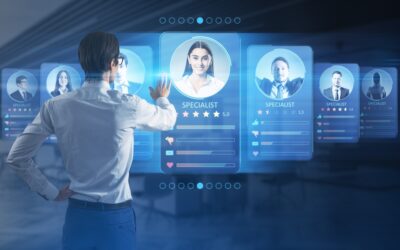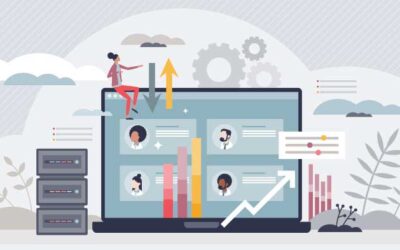The Transformation of Cybersecurity Risks in HR
Gone are the days when HR was solely about personnel management and paper-based records. Today, the digital age has ushered in a new era where HR operations are intertwined with sophisticated software, cloud-based platforms, and mobile applications.
This digital transformation has undoubtedly brought about efficiency and streamlined operations. Tasks that once took days, such as sorting through stacks of resumes or manually tracking employee hours, can now be accomplished in mere minutes. HR professionals can now focus on more strategic roles, such as talent management, employee engagement, and organizational development.
However, with these advancements comes a new set of challenges, particularly in the realm of cybersecurity. The digitization of employee records, from personal identification details to financial information, makes HR departments a lucrative target for cybercriminals. The data held within HR systems is not just of value to the organization but also holds significant worth on the dark web.
A simple phishing attack targeting an unsuspecting HR employee could lead to a massive data breach, putting both the company’s reputation and its employees’ identities at risk. Moreover, the rise of remote work, especially in the wake of global events like the COVID-19 pandemic, has further expanded the threat landscape. HR professionals now have to ensure the security of data accessed from various devices and locations, adding another layer of complexity to their roles.
But it’s not all doom and gloom. The same technology that presents these challenges also offers solutions. Advanced cybersecurity tools, powered by artificial intelligence and machine learning, can detect and mitigate threats in real-time. Encryption technologies ensure that even if data is intercepted, it remains unreadable to unauthorized entities.
Why Employee Data is a Prime Target
Employee data, with its rich tapestry of personal, financial, and health-related details, stands out as a veritable goldmine for cybercriminals. But what makes this particular set of data so enticing?
First and foremost, the sheer comprehensiveness of employee data is unparalleled. From Social Security numbers to bank account details, from home addresses to medical histories, HR departments hold a treasure trove of information. This data, when pieced together, can paint a detailed portrait of an individual, making it a prime target for identity theft. A single successful breach can provide cybercriminals with enough information to commit multiple fraudulent acts.
Moreover, the financial implications of accessing employee data are immense. With the right set of details, cybercriminals can siphon off funds, make unauthorized transactions, or even divert salaries. The direct monetary gain from such activities is a significant driving force behind the relentless pursuit of this data.
But it’s not just about money. Employee data can also be weaponized for corporate espionage. Knowledge of an employee’s personal circumstances, habits, or vulnerabilities can be exploited to gain insider information, manipulate decisions, or even coerce individuals into acting against their organization’s interests.
Real-world Breaches: Lessons Learned
Equifax: A Wake-up Call on System
Vulnerabilities In 2017, Equifax, one of the largest credit reporting agencies, suffered a massive breach that exposed the personal data of 147 million people. While not strictly an HR breach, the exposed data included names, Social Security numbers, birth dates, and addresses. The breach was attributed to a vulnerability in a web application framework. The lesson? Regularly update and patch software systems. Even a small vulnerability can lead to significant data exposure.
Anthem: The Cost of Phishing Attacks
In 2015, Anthem, a leading health insurance company, reported that hackers had accessed the personal information of nearly 78.8 million current and former customers and employees. The breach was the result of a successful phishing attack on an Anthem employee. This incident underscores the importance of continuous employee training on cybersecurity best practices.
Morrisons: The Insider
Threat In 2014, a disgruntled employee of Morrisons, a UK supermarket chain, leaked the payroll data of nearly 100,000 staff. The data included bank account details, salaries, and addresses. The breach highlighted the potential risks posed by internal actors and the need for stringent access controls and monitoring.
Deloitte: The Importance of Multi-factor Authentication
In 2017, Deloitte, a global consultancy firm, faced a breach that exposed confidential emails and plans of some of its blue-chip clients. The breach was attributed to a lack of multi-factor authentication in one of its email platforms. The incident serves as a reminder of the importance of layered security measures.
Lessons to Take Home While each breach had its unique causes and consequences, some common lessons emerge:
- Regularly update and patch systems.
- Train employees continuously on cybersecurity best practices.
- Implement stringent access controls and monitor data access.
- Employ layered security measures, including multi-factor authentication.
By understanding these real-world incidents and their repercussions, HR departments can better equip themselves against the ever-evolving threats of the digital world.
The Role of Employee Training in Cybersecurity
There’s a factor often overlooked but of paramount importance – the human element. While advanced security tools and protocols are essential, the role of individual employees in safeguarding a company’s digital assets cannot be understated.
Every employee, regardless of their position or department, interacts with company data in some form. Whether it’s accessing the HR portal, using company email, or working with client databases, each interaction poses a potential security risk. This is especially true if employees are unaware of the threats they might inadvertently introduce or the best practices to prevent them.
This is where employee training comes into play. A well-informed employee can act as the first line of defense against cyber threats. By understanding the basics of phishing attacks, the importance of strong password practices, and the risks of unsecured networks, employees can significantly reduce the chances of a security breach.
However, not all training methods are created equal. A table comparing various training approaches might reveal that interactive workshops are more effective than simple video tutorials. Real-world simulations, where employees face mock phishing attempts or malware threats, can offer invaluable hands-on experience. These practical exercises not only test their knowledge but also reinforce learning through real-time feedback.
Moreover, continuous training is key. The world of cyber threats is ever-evolving, with new tactics emerging regularly. Annual or bi-annual training sessions ensure that employees stay updated on the latest threats and the best countermeasures against them.
While technology plays a crucial role in cybersecurity, the human aspect is equally vital. By investing in comprehensive employee training, companies not only bolster their defense against cyber threats but also foster a culture where every individual understands their role in protecting the organization’s digital assets.
Advanced Tools and Technologies for Data Protection
HR departments cannot afford to rely solely on traditional security measures. The digital landscape is evolving, and with it comes a new wave of advanced tools and technologies designed specifically to protect sensitive data. Let’s dive into some of these cutting-edge solutions that are reshaping the way HR safeguards employee information.
AI-Driven Threat Detection
Artificial Intelligence (AI) is no longer just a buzzword. In the realm of cybersecurity, AI algorithms are trained to detect unusual patterns and behaviors that might indicate a potential threat. By continuously monitoring and analyzing vast amounts of data, these systems can identify and flag anomalies in real-time, allowing for swift intervention.
Encrypted Cloud Storage Solutions
Cloud storage has become a staple for many organizations, offering flexibility and scalability. However, not all cloud solutions are created equal. Top-tier providers now offer end-to-end encryption, ensuring that data remains unreadable even if intercepted during transmission. This level of encryption ensures that employee records, financial details, and other sensitive HR data remain secure.
Blockchain for Data Verification
While blockchain is often associated with cryptocurrencies, its applications in cybersecurity are vast. Blockchain can create tamper-proof logs of data access and modifications. For HR, this means a transparent and immutable record of who accessed employee data, when, and what changes were made, providing an added layer of accountability.
Biometric Authentication
Passwords can be cracked, and security questions can be guessed. But biometric data, like fingerprints or retina scans, offers a unique and hard-to-replicate method of authentication. More HR software solutions are integrating biometric authentication to ensure that only authorized personnel can access sensitive data.
Zero Trust Network Architecture
Gone are the days when anything within the company’s network was automatically trusted. The zero trust model operates on the principle of “never trust, always verify.” Every access request, whether from inside or outside the organization, is treated as a potential threat and must be verified before access is granted.
As cyber threats grow in sophistication, so too must the tools and technologies used to combat them. HR departments, tasked with safeguarding some of the company’s most sensitive data, must be at the forefront of adopting and implementing these advanced solutions. By doing so, they not only protect their employees but also uphold the trust and reputation of the organization.
Walking the Tightrope of Data Protection Laws in HR
where data breaches are becoming increasingly common, legal compliance isn’t just a matter of ticking boxes; it’s a necessity for safeguarding a company’s reputation and financial health. For HR departments, the stakes are even higher. They handle a plethora of sensitive employee data, making them prime targets for cyberattacks.
Data protection laws worldwide have been established to ensure that personal data is handled with the utmost care. These laws not only set the standards for data protection but also impose hefty penalties on organizations that fail to comply.
One of the most notable regulations in this domain is the General Data Protection Regulation (GDPR) in the European Union. GDPR has set stringent standards for data protection, granting individuals greater control over their personal data. For HR departments, this means ensuring explicit consent for data collection, providing transparency about data usage, and ensuring the right to data erasure.
Across the pond, in the United States, there isn’t a single federal law governing data protection. Instead, there are sector-specific laws like the Health Insurance Portability and Accountability Act (HIPAA) for health information and the Fair Credit Reporting Act (FCRA) for consumer reports. HR departments need to be aware of state-specific laws too, such as the California Consumer Privacy Act (CCPA), which grants Californians the right to know how their personal data is being used.
In the Asia-Pacific region, countries like Singapore have the Personal Data Protection Act (PDPA), which mandates organizations to protect personal data in their possession. Similarly, Australia’s Privacy Act requires organizations to handle personal information transparently.
For HR professionals, navigating this maze of regulations can be daunting. But it’s essential to understand the nuances of each law, especially for multinational corporations operating across different jurisdictions. Regular training sessions, workshops, and seminars can keep the HR team updated on the latest in data protection laws.
While technology can act as a shield against cyber threats, legal compliance acts as the safety net, ensuring that even in the event of a breach, the organization has taken all necessary precautions to protect employee data.
The Human Element: Building a Security-conscious Culture
Employees, regardless of their role or seniority, play a pivotal role in the security posture of an organization. It’s a collective responsibility, and HR departments are uniquely positioned to lead the charge in cultivating a security-conscious culture.
While advanced firewalls and encryption tools are essential, they can be rendered ineffective if employees are careless with their login credentials or unknowingly click on malicious links. Human error remains one of the leading causes of data breaches. This underscores the importance of ensuring every team member is equipped with the knowledge and mindset to act as a human firewall.
One of the first steps in building this culture is regular training. But it’s not just about hosting an annual seminar on cybersecurity. It’s about making security an ongoing conversation. Monthly newsletters, regular updates on emerging threats, and interactive workshops can keep the topic at the forefront of employees’ minds.
Moreover, it’s crucial to move away from a culture of blame. If an employee does fall for a phishing scam or forgets to log out from a public computer, it should be treated as a learning opportunity rather than an occasion for reprimand. When employees fear punitive measures, they’re less likely to report potential security incidents, making it harder for the organization to respond promptly.
Incentives can also play a role. Recognizing and rewarding employees who demonstrate exceptional security awareness can motivate others to follow suit. Whether it’s a shout-out in the company newsletter or a small bonus, acknowledging proactive security behaviors can go a long way.
Lastly, HR can lead by example. By demonstrating best practices, from regularly updating passwords to being cautious about email attachments, HR can set the standard for the rest of the organization.
Preparing for the Worst: Response Plans for Data Breaches
Data breaches are not a matter of “if” but “when.” For HR departments, which handle sensitive employee data, being prepared for such breaches is paramount. A robust response plan can make the difference between a swift recovery and lasting damage to a company’s reputation and bottom line.
The first moments after detecting a data breach are critical. HR departments, often the first line of defense, must act quickly and decisively. Here’s a step-by-step guide to navigating these turbulent waters:
- Immediate Isolation Upon detecting a breach, the affected systems should be isolated immediately. This action prevents further unauthorized access and limits the spread of potential malware or ransomware.
- Assemble the Response Team Every organization should have a designated data breach response team. This team, comprising IT, legal, communications, and HR professionals, should convene immediately to assess the situation and coordinate the response.
- Document Everything From the moment a breach is detected, every action taken should be meticulously documented. This record not only aids in understanding the breach but is also crucial for legal and regulatory compliance.
- Notify Affected Parties Transparency is key. Employees whose data might have been compromised should be informed as soon as possible. Clear communication about what happened, the data at risk, and the steps being taken is essential to maintain trust.
- Engage Cybersecurity Experts If the breach is beyond the organization’s capacity to handle, third-party cybersecurity experts should be engaged. These professionals can help identify the breach’s source, assess its extent, and recommend remediation steps.
- Review and Update Security Protocols Once the immediate threat is contained, it’s time for a thorough review. What vulnerabilities were exploited? How can they be addressed? Regular audits and updates to security protocols can prevent future breaches.
- Train and Educate Employees Often, breaches occur due to human error or oversight. Regular training sessions can ensure that all employees are aware of best practices and the latest threats.
- Communicate with Stakeholders Beyond the affected employees, other stakeholders, including shareholders, customers, and partners, might need to be informed, depending on the breach’s nature and extent.
- Monitor for Aftereffects Post-breach, continuous monitoring is essential. Cybercriminals might attempt to use the stolen data or find other entry points into the organization’s systems.
While data breaches are a daunting challenge, a well-prepared HR department can lead the way in ensuring a swift and effective response. By being proactive and having a clear plan in place, HR can safeguard not just employee data but also the organization’s reputation and future.
Looking Ahead: The Future of Cybersecurity in HR
The realm of cybersecurity is ever-evolving, and as HR continues its digital transformation, it’s imperative to stay ahead of potential threats. The future of cybersecurity in HR is not just about countering risks but also about leveraging technology to create a safer, more efficient environment for employee data.
Emerging Threats on the Horizon
While traditional cyber threats like phishing and malware remain prevalent, new challenges are emerging. Sophisticated attacks, such as AI-driven cyber threats, are on the rise. These threats use artificial intelligence to mimic human behavior, making them harder to detect and counter.
The Rise of Quantum Computing
Quantum computing, with its immense computational power, poses both opportunities and challenges. On the one hand, it can revolutionize encryption methods, making data more secure. On the other, it has the potential to break many of the current encryption algorithms, necessitating a complete overhaul of current security protocols.
Biometric Security in HR
As HR departments increasingly turn to biometric data for employee verification, ensuring the security of this sensitive data becomes paramount. Future HR systems might leverage advanced biometric security, from retina scans to voice recognition, ensuring a higher level of data protection.
Decentralized Systems and Blockchain
Blockchain technology, with its decentralized nature, offers a promising solution for HR data security. By storing employee data across a network of computers, blockchain reduces the risk of centralized data breaches. Moreover, its transparent and immutable ledger ensures data integrity and authenticity.
Predictive Analytics for Threat Detection
The future might see HR departments using predictive analytics to preemptively identify potential security threats. By analyzing patterns and anomalies in data access and usage, these systems can alert HR professionals to suspicious activities in real-time.
In essence, the future of cybersecurity in HR is a blend of challenges and innovations. While new threats will undoubtedly emerge, so will cutting-edge solutions to counter them. HR professionals must remain vigilant, continuously updating their knowledge and tools to safeguard the invaluable asset that is employee data.




